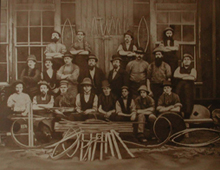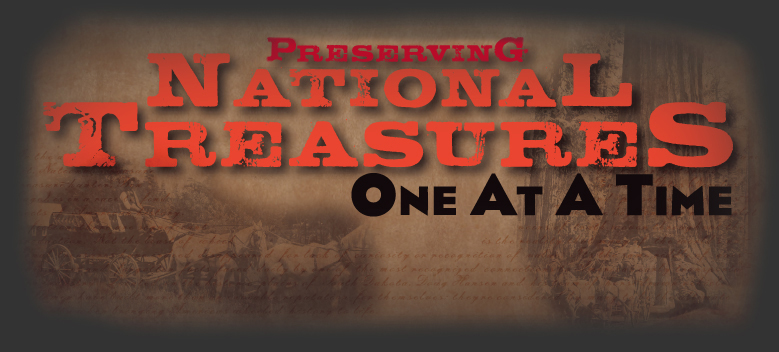While the high-energy movie plot is fiction, there are significant veins of truth woven throughout the production. Not the least of which is the reality that many of the world’s national treasures have indeed disappeared for lack of curiosity or recognition of value. It’s the same riddle of questions, clues and forgotten facts faced daily by one of the most recognized connections to America’s early transportation industry. Located on the historic plains of South Dakota, Doug Hansen and his team of horse-drawn vehicle craftsmen have built more than an enviable reputation for themselves; they’re considered by many to be the ultimate authority when bringing America’s wheeled history to life.
Recently, Hansen was tasked with the research and restoration of an early touring stagecoach from the Mariposa Grove in Yosemite National Park. The Grove is well known for the hundreds of Giant Sequoia trees in the area. While today’s travelers to the region enjoy the comfort and convenience of paved roads and motorized transportation, yesterday’s guests braved nature’s elements in open-sided coaches drawn by four to six horses. Dating to the late 1800’s, the coach sent to Hansen’s shops was designed with front, rear and side-mounted leaf springs as well as two inch wide steel tires and rear wheels measuring nearly five feet in diameter. Working together, these features are specifically engineered to help smooth out travel over difficult terrain. The coach belongs to the Madera County (California) Historical Society and, according to Doug Sordi, Vice-President of the organization, it shares a rich history with the ‘Big Trees.’ Abraham Lincoln first recognized Yosemite as a state park in 1864 and in 1877, the original owner of this coach, the Yosemite Stage and Turnpike Company, began passenger service to the Giant Sequoias in Mariposa Grove.
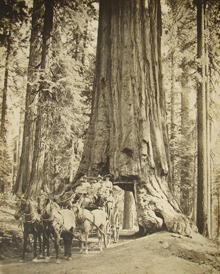
Operating routes that ran more than 70 miles, the company placed stage stations at regular intervals to allow for horse changes, vehicle maintenance and other needs. In the early days, just getting to the Big Trees was not without its share of excitement. Many of the trips took all day to arrive at the remote destinations. Along the way, coach drivers and horses, alike, had to negotiate steep, narrow mountain roads with sheer drops and switchback curves. Adding to the unforgettable journeys, the tour outings were sometimes met with the unexpected tension of masked gunmen demanding valuables. The first such event occurred in 1883 when passengers were coaxed at gunpoint to hand over $2,000 worth of cash and jewelry.
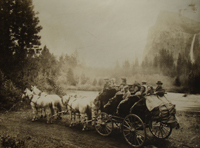
Today, most surviving horse-drawn stages are relegated to museums; beyond the interactive experience of 21st century travelers. The restoration of this rare Yosemite Stage & Turnpike coach will allow it to be used as a head-turning showpiece in special events promoting the Madera County Historical Society. According to Sordi, “We’ve had this vehicle, along with two other Yosemite touring coaches, in our collection for some time. The opportunity to share such an important part of history in a hands-on way with our community is a real privilege. It’s a great way to bring American history to life while also reinforcing the unity and identity of our area.”
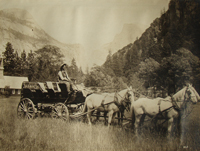
Start talking about original western vehicles and Hansen is equally quick to share his passion for this vital part of America’s past. From giant freight wagons with tons of payload capacity to authentic chuck wagons and rare Concord stagecoaches that plied the legendary Overland Mail Routes, Hansen has seen a world of history pass through his shops. One look at the projects in line for work is a jolting reminder of the uniqueness of each day here. Far from the mundane, predictable nature of many jobs, the ever-changing assignments have a way of fostering enthusiasm as well as challenges. According to Hansen, “Re-commissioning this 12 passenger (11 plus driver) coach presented us with a number of puzzles. It’s a wonderful piece of Americana,” says Hansen, “But, like so many other celebrated western vehicles, over the years a number of its components were either lost, damaged or weakened. Throughout the restoration, our primary mission has been to maintain authenticity while also preserving the historic integrity of the piece .”
Using an impressive compilation of period photography, patterns and literature along with decades of experience, the team was able to reconstruct the damaged and missing parts of the coach. Layers of non-original paint were painstakingly removed to determine initial colors as well as striping and lettering styles and locations. Interestingly, after the coach was received and its features were being cataloged, a small caliber bullet was found lodged in a structural frame member. Whether this coach had been victim of a holdup or merely a careless shot in target practice may never be known.
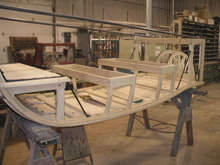
For horse drawn vehicles over a century old, the process of restoration is anything but simple. In fact, industry experts agree that it can easily take longer to restore a quality piece than the time it would have taken to originally construct the vehicle. From the background research, vehicle documentation, disassembly, paint stripping, sanding, replacement of parts, rebuilding and reassembly, this coach has more than 800 hours of reconstructive surgery. The results are easy to see and even easier to appreciate. The age-stained undercarriage and rebuilt wheels retain the authentic look of the original gear while the deep red body, gold tone lettering and upholstered seating are a solid match to the original photos. From the custom, steam bent woodwork to the hand-forged iron; attention to detail dominates this work. “It’s more than a job,” says Hansen. “We spend a lot of time with these vehicles. In the process, there’s a connection that becomes very personal and when you consider that these classic western designs carried Presidents, dignitaries, and other VIP’s of the day, it’s easy to understand how this approach to art, history and old world craftsmanship both consumes and rejuvenates us. To have a part in helping secure so much history is a huge reward in itself.”
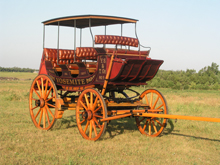
From legendary overland mail coaches to lighter touring coaches like this one, the lure and legacy of a vintage stagecoach continues to make it one of the most important and sought after vehicles in any collection. Without exception, they’re one of the most recognized symbols of 19th century America. Just like the centuries-old Giant Sequoias of Mariposa Grove, these wheels are yet another national treasure; carrying a powerful spirit of independence while standing as a larger-than-life icon of the great American West.
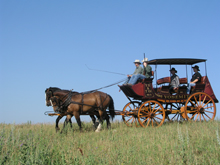
EDITOR'S NOTE...
While gathering information for this story, the folks at Hansen Wheel and Wagon Shop sent us photographs showing the disassembled suspension springs from the touring coach. Stamped into the springs was the name of Betts Spring Company - San Francisco, California. The discovery of the Betts brand provides another interesting perspective to the significant role of American ingenuity and opportunity.
As it turns out, when it comes to true western vehicle history, Betts is a thriving modern day icon. With a heritage tracing to 19th century England, the company began its operations in America in 1868. Among its early offerings were springs and related hardware for the horse drawn vehicle industry, cable cars and other products. Company founder, William Betts I, is credited as being the first spring manufacturer west of the Mississippi and was awarded a gold medal for his achievements at the 1871 San Francisco Mechanics Exhibition.
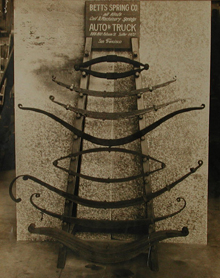
Due to its product innovation and diversity, the company was able to successfully navigate the passing of the horse drawn era and, today, is a recognized leader of innovative spring technology. Equally to its credit, after nearly a century and a half in business, the company is still owned by the Betts family. It’s an accomplishment unmatched by any other U.S. spring manufacturer. As a formidable 21st century competitor, Betts serves as a vital source of springs for the modern transportation industry and a myriad of other products including exercise equipment, mountain bikes, medical technology, military weapons and space shuttles.
The vast connections early western vehicles have to America’s past and present never ceases to amaze us. Like the pursuit of other early world treasures, this discovery of a simple stamp in the springs of a touring coach is another reminder that greater awareness of our past can provide even stronger encouragement for the future.
